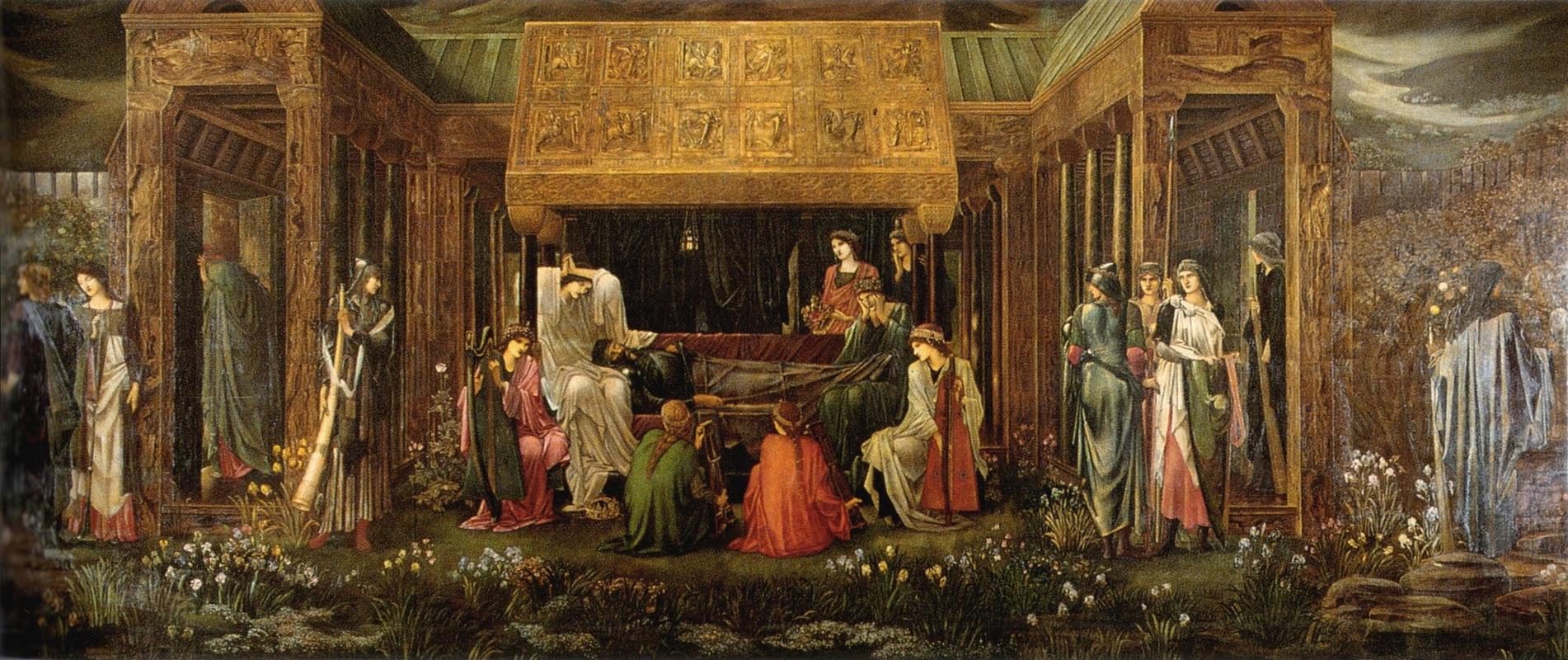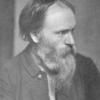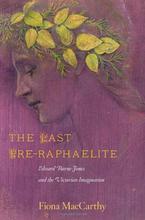More about The Sleep of King Arthur in Avalon
- All
- Info
- Shop

Contributor
Burne-Jones’ The Sleep of Arthur in Avalon is the artist’s magnum opus, despite the fact that he died before he finished it.
Starting in 1881, Burne-Jones worked on this piece for seventeen years – thirteen of which were the last of his life. The end was always just around the corner, but unfortunately so was death. By the time he died, Burne-Jones estimated that he had about two months left of work on the artwork. All he needed to do was tie up some loose ends, but alas it was not to be. If you look closely, “some of the instruments have no strings and figures have socks but no shoes.” But at 9 by 21 feet, the piece was just too big for anyone to finish, especially the perfectionist Burne-Jones.
He was so obsessed with it that at one point he resented an invitation to Queen Victoria’s jubilee celebration at the palace. He went, but he wasn’t happy about it and didn’t stay long. It was a borderline psychotic obsession, but his wife put it more gently. She said that for her husband, The Sleep of Arthur in Avalon was "A task of love to which he put no limit of time or labor."
The piece depicts King Arthur, who has been mortally wounded lying in the center of the canvas, with his head on the lap of his sister, Queen Morgan le Fay, who has brought him to the vale of Avalon to die. Like Burne-Jones as he painted this, King Arthur isn’t dead yet. The painting takes place in the eerie moments before the end. As his biographer, Fiona MacCarthy put it, “Arthur in Avalon is full of this weird stillness, the sense of time suspended that admirers of his paintings, including Picasso, regarded as quintessential Burne-Jones.” MacCarthy also made the awful connection that the artist might have been procrastinating on finishing this piece because he knew that the end of the painting would be the end of his life as well. Thanks for that, Fiona…
This painting was commissioned for Burne-Jones’ patron, George Howard, 9th Earl of Carlisle, to hang in his library at Naworth Castle. Obviously the commission didn’t work out because Burne-Jones died, but there was also a time four years into the making of the piece when the artist had to put the work aside and give his patron a smaller one with just a dying King Arthur instead of the whole shebang. At the time, all of the artist's friends were dying, and his own health was failing. He was complaining of a “throbbing heart and failing eyesight.” He began sleeping in the same pose as King Arthur, which was just too much to handle. But he would live to work on it again for another 13 years.
In 1963, Don Luis Ferré, the governor of Puerto Rico and the founder of the Ponce Museum of Art, bought the painting and, besides a quick stint in England when the Ponce Museum of Art was undergoing some renovations,The Sleep of Arthur in Avalon has been experiencing island life ever since.
Sources
- "Burne Jones's Last Painting To Be Exhibited In The UK For The First Time In Over 40 Years." Theartwolf.com. N.p., 2018. Web. 4 Sept. 2018.
- MacCarthy, Fiona. "Fiona Maccarthy On Edward Burne-Jones's The Sleep Of Arthur In Avalon." the Guardian. N.p., 2008. Web. 4 Sept. 2018.
- "Moving Sir Edward Coley Burne-Jones’ The Sleep Of Arthur In Avalon From Puerto Rico To London: Moving Sir Edward Coley Burne-Jones’ The Sleep Of Arthur In Avalon From Puerto Rico To – Project | Tate." Tate. N.p., 2008. Web. 4 Sept. 2018.
- "Museo De Arte De Ponce." Museoarteponce.org. N.p., 2018. Web. 4 Sept. 2018.
Featured Content
Here is what Wikipedia says about The Last Sleep of Arthur in Avalon
The Last Sleep of Arthur in Avalon is a painting by the English artist Edward Burne-Jones, started in 1881. The massive painting measures 279 cm × 650 cm, and is widely considered to be Burne-Jones's magnum opus.
The painting was originally commissioned from Burne-Jones by his patron George Howard, 9th Earl of Carlisle, to hang on a wall in the library of Naworth Castle. Howard shared Burne-Jones's affection for the Arthurian legend and left the choice of topic to the artist. Burne-Jones started working on it in 1881 and continued for 17 years. Within this period, he also designed the stage set for the play King Arthur by J. Comyns Carr that premiered in London in January 1895.
The 1880s brought the deaths of Burne-Jones's close friends. As they died, the artist experienced mounting isolation and painful awareness of his own mortality. Immersed in his work, Burne-Jones identified himself with Arthur and even adopted Arthur's pose when he himself slept. By 1885, the association with Arthur reached the point where Burne-Jones had to ask Howard to cancel or revise his original commission, replacing the grand scene with a smaller painting focused on the departed king. Howard agreed to the cancellation and never requested his down payment back. Nevertheless, Burne-Jones returned to the original grand painting and worked on it for the remaining thirteen years of his life. Arthur became increasingly autobiographical for the artist as he withdrew into himself; "above all, the picture is about silence."
How is it you are in Avalon, where I have striven to be with all my might — and how did you get there and how does Arthur the King? ...
— Edward Burne-Jones, a letter to a friend in Avallon, France, 1886
A popular opinion holds that Burne-Jones modelled Arthur's appearance after William Morris, the last survivor of a once-strong progressive art circle, and that Morris's physical decline was a major inspiration for the painting. However, Debra Mancoff argues that there is no record of Morris posing as Arthur and that the king's image was completed when Morris was in vigorous health. Morris died in 1896; Burne-Jones lived for two more years and died before the painting was complete. Just one day before his death, Burne-Jones continued work on Arthur. Towards the end of his life, he wrote, "I need nothing but my hands and my brain to fashion myself a world to live in that nothing can disturb. In my own land, I am king of it." His widow described Arthur as a "task of love to which [the artist] put no limit of time or labour."
Following the artist's death in 1898, the painting in its frame with Latin inscription passed from his executors to Sydney Goldman, who was acquainted in Rottingdean with Burne-Jones. His sons, John and Penryn Monck, sold the work at auction at Christie's on 26 April 1963. There it was bought by Luis A. Ferré, a politician and founder of the Ponce Museum of Art who would later become Governor of Puerto Rico. Burne-Jones was out of fashion at this time so its export was allowed despite some objections.
The Last Sleep of Arthur in Avalon is owned by the Ponce Museum of Art in Puerto Rico. It was exhibited at Tate Britain in London in 2009–10 while the Ponce museum underwent restoration. The painting was also on view at that time at the Prado Museum in Madrid for the exhibition The Sleeping Beauty: Victorian Painting from The Museo de Arte de Ponce (2 February 2009 – 31 May 2009).
Check out the full Wikipedia article about The Last Sleep of Arthur in Avalon













